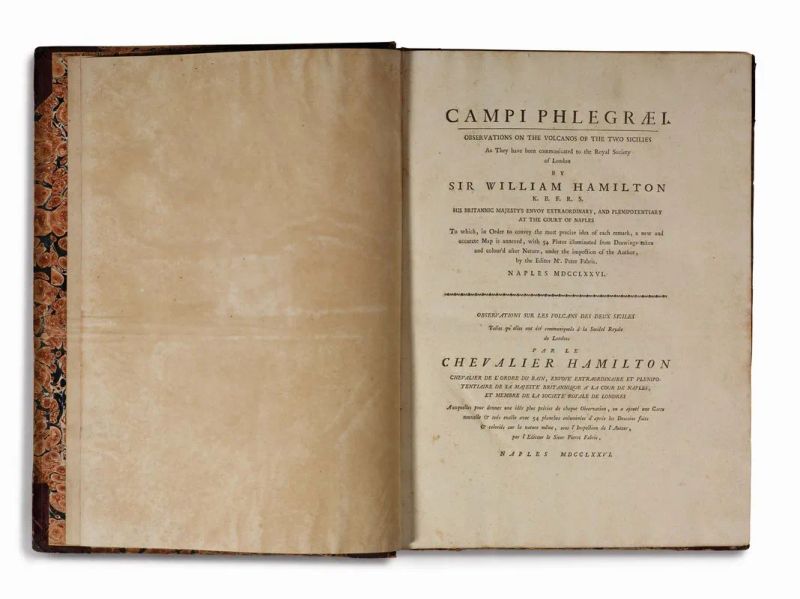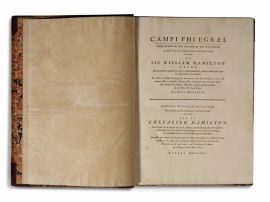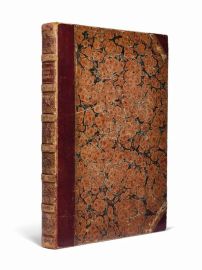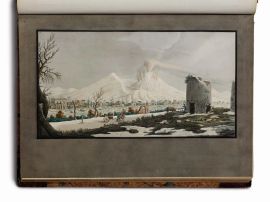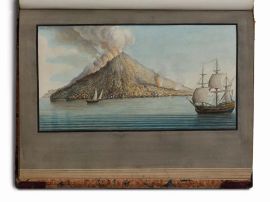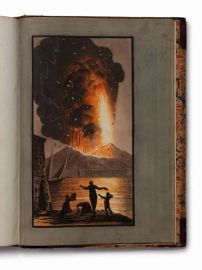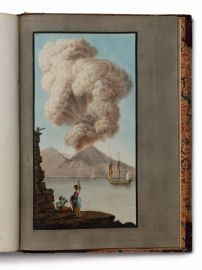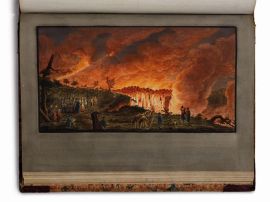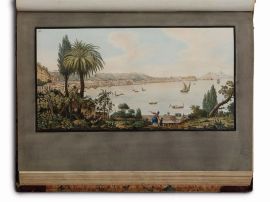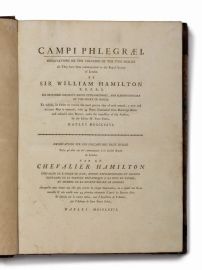Sir William Hamilton
(Henley-on-Thames 1730 - London 1803)
CAMPI PHLEGRAEI. OBSERVATIONS ON THE VOLCANOS OF THE TWO SICILIES.
Naples, [Pietro Fabris], 1776.
[Bound with:]
Supplement to the Campi Phlegraei. Being an Account of the Great Eruption of Mount Vesuvius in the Month of August 1779.
Naples, [Pietro Fabris], 1779.
Folio (460 x 335 mm). Typographical title page; hand-coloured double-page map of the Bay of Naples, engraved in 1776 by Giuseppe Guerra after Pietro Fabris; [1] l. with “References to Plate I”; hand-coloured chalcographic title-page with six vignettes depicting the Aeolian Islands; pp. 3-90; [1] l. with imprimatur; typographical title page; [53] ll. of text alternating with [53] hand-coloured chalcographic plates numbered II-LIIII; typographical title page of the Supplement; [1] l. with “References to Plate I”; hand-coloured chalcographic title-page with six vignettes depicting the eruption of Vesuvius; pp. 1-29 [1]; [1] l. with a dedication to Ferdinand IV; [4] ll. of text alternating with [4] hand-coloured chalcographic plates numbered II-V. Complete. Contemporary long-grain red half morocco; spine with six nerves and seven finely gilt compartments, the second with gilt lettering; marbled covers, endpapers and edges; gilt floral roll on covers. Occasional pale age-toning, binding slightly rubbed, but overall a very good copy.
Title and text in English and French, on two columns.
Provenance: Lyons Library (heraldic bookplate on inside front cover); Pregliasco sale, Turin, December 1940 (bibliographic record); private collection.
Bibliography: Brunet III 31. Graesse III 205. Jenkins and Sloan, Vases and Volcanoes. Sir William Hamilton and His Collection, British Museum Press, 1996. Lewine 232. Lowndes II 989. Rudwick, Bursting the Limits of Time, 2005, p. 30.
MAGNIFICENT COPY OF THE FIRST EDITION OF THE FAMOUS WORK OF SIR HAMILTON ON ITALIAN VOLCANOES, BEAUTIFULLY ILLUSTRATED WITH 59 ETCHINGS WITH FINE CONTEMPORARY HAND-COLOURING.
Unanimously considered as an editorial masterpiece and one of the most beautiful books of the 18th century, Hamilton’s Campi Phlegraei is a milestone in the fields of both book illustration and volcanological research.
The name “Campi Flegrei”, or “lands burned by fire”, designates the vast area that includes Naples and its surroundings that is characterized by a lively volcanic activity since antiquity. In fact, Vesuvius, its spectacular eruptions, and the places that surround it are the undisputed protagonists of this work. But it should be pointed out that the meticulous volcanological research conducted by Hamilton also involved other volcanoes of southern Italy, in particular those of the Aeolian Islands and Mount Etna; most of them appear in plates and commentaries of the book.
Hamilton’s modern approach to scientific inquiry, which made the Campi Phlegraei a revolutionary text in the field of volcanology, is laid out by him in his introductory letter of the work, addressed to Sir John Pringle, president of the Royal Society of London, of which Sir William was a member since 1766. Unlike the naturalists of the past, whose theories were mostly conceived and developed at their desks, Hamilton, a true apostle of Enlightenment, believed that nature should be studied with accurate and detailed live observations; these should be then reported in the most faithful and understandable way.
Therefore, the text of Campi Phlegraei, which consists of the series of letters sent by Hamilton to the Royal Society between June 10, 1766 and October 1, 1779, is basically a very detailed record of his many ascents to Mount Vesuvius and excursions to its surrounding areas. During these trips, he recorded every volcanic phenomenon worthy of relief and came to the innovative and fundamental conclusion that the activity of volcanoes has a decisive impact on the earth’s surface and the shaping of the landscape.
In the same letter to Pringle, Hamilton also describes both the genesis of the spectacular plates that adorn the work and the publishing history of the book. True to his modern scientific methodology, he wished that his report were accompanied by images that reproduced precisely and in detail what he observed. He commissioned the work to Pietro Fabris, whom he called “a most ingenious and able artist”, and asked him to draw each volcanic place they visited, as well as samples of volcanic rocks and particular eruptions. These include the Vesuvius eruptions occurred at the turn of 1760 and 1761, the night of 20 October 1767 and 11 May 1771, and in August 1779. The latter is the subject of the entire Supplement to Campi Phlegraei.
Hamilton supervised directly the work of Fabris, who accompanied him in his excursions. In fact, the two men are portrayed in many plates, the first with a red coat, the second in blue. Fully satisfied with the artist’s work, which he described as executed with “the uttermost fidelity” and “as much taste as exactness”, Hamilton decided that what he had initially requested for his personal satisfaction was instead published for the benefit of a wider audience. He entrusted again the enterprise to Fabris and took on the huge costs, requiring that the plates reproduced the original drawings “with such delicacy and perfection, as scarcely to be distinguished from the original drawings themselves”.
Not surprisingly, even nowadays those who browse a copy of Campi Phlegraei are awed by the colouristic virtuosity of its plates, which, as Hamilton wrote, truly seem original drawings. But Fabris’ images also amaze because they are entirely pervaded with the concept of “sublime”, obtained by the contrast between a Nature that is portrayed in all its vastness and power and the tiny size of the human figures that inhabit it. Many views feature small scenes of everyday life, as well as minute depictions of buildings, transport and local flora.
The subjects of the plates include numerous images of craters and lava layers on Mount Vesuvius and other volcanoes; views of various volcanic locations of Campania; illustrations of lakes and of ample landscapes; spectacular and dramatic eruptions at night and during the day; views of the Gulf of Naples and Posillipo, Pozzuoli, the Solfatara, Porto Paone at the island of Nisida, Ischia, Ventotene, and Stromboli, Etna from Catania, the excavations at the temple of Isis in Pompeii. Plates from 42 to 54 reproduce samples of tuff, pumice stone, types of lava and marble, curious volcanic rocks. The plates of the Supplement, the most famous and reproduced, and are even more spectacular and beautiful in their representation of the extraordinary eruption of Vesuvius in 1779.
Each of the 54 plates of Campi Phlegraei and of the 5 in the Supplement is accompanied by a page with captions describing with scientific precision every detail depicted by Fabris. In many captions, Hamilton also wanted to add what the purpose of that particular table was, and what he wanted to show through it.
A Scottish nobleman and a man with versatile interests, Sir William Hamilton was a distinguished diplomat, volcanologist, archaeologist, antiquarian and collector. He grew up at the court of King George II, his mother being his mistress. Initially, he embarked on a military career, which he abandoned when he married his first wife, Catherine Barlow. Given the poor health of the latter, in 1764 he requested and obtained the role of British Ambassador to the Kingdom of Two Sicilies, a position he held until 1800. He then moved to Naples, where, in addition to fulfilling his diplomatic duties and welcoming at its famous villas guests as Mozart, Goethe and Horatio Nelson, he devoted himself actively to his two passions: collecting antique vases and studying volcanoes.
In 1766, he sent to the Royal Society of London a first record of the eruption of Vesuvius in the summer of that year, an essay thanks to which he was appointed member of the prestigious society. In 1770, the report of his trip to Etna also granted him the Copley Medal, the highest award in science conferred by the Royal Society.
His beloved Catherine died in 1782. Hamilton remarried later with Emma Hart, 35 years younger, famous for her beauty and for her liaison with Admiral Nelson. The scandal has inspired Susan Sontag's novel The Volcano Lover (1992).

